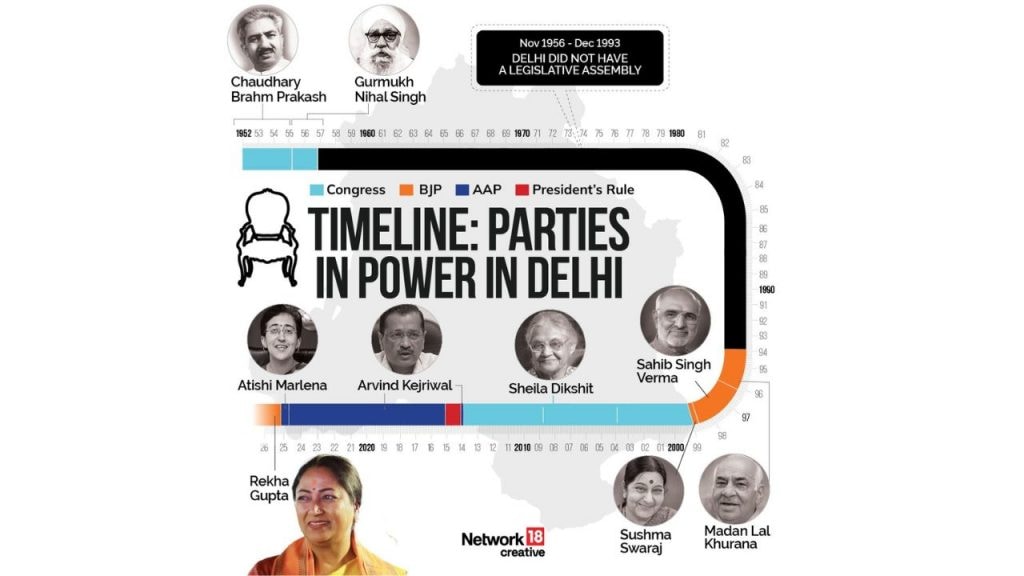The Bharatiya Janata Party (BJP) on Wednesday (February 19) finally revealed the name of Delhi’s next chief minister, ending an 11-day suspense. First-time MLA Rekha Gupta’s name was confirmed as next Delhi’s CM by the party’s leadership. Gupta would be Delhi’s fourth woman chief minister, following BJP’s Sushma Swaraj, the Congress’s Sheila Dikshit and the Aam Aadmi Party’s Atishi.
The BJP won the Delhi assembly polls earlier this month, clinching 48 seats in the 70-seat assembly. The party returned to power for almost 27 years.
As Gupta looks set to assume the role of Delhi chief minister, her topmost challenges include tackling air and river pollution and poor infrastructure in the Indian capital territory.
Over the last seven decades, Delhi has been ruled by three political parties, namely the BJP, Congress and the Aam Aadmi Party (AAP).
Here’s the timeline of Delhi’s political history, spanning from Congress’s rule in 1952 to now BJP’s stunning comeback after 27 years of exile. Let’s have a closer look.
Chaudhary Brahm Prakash: The Congress leader became Delhi’s first chief minister and held the chair from March 1952 to February 1955.
Gurmukh Nihal Singh: The Congress leader held the top position from February 1955 to November 1956.
After five years of Congress’s rule, Delhi saw a major change in its political governance as the States Reorganisation Commission (1955) headed by Justice Fazl Ali concluded that “a separate state government” for Delhi was no longer required.
Starting November 1, 1956, Delhi ceased to be a Part-C State, which meant Delhi Legislative Assembly and the Council of Ministers were abolished and Delhi became a Union Territory under the direct administration of the President of India.
However, the Parliament of India passed the Constitution (69th Amendment) Act, 1991, which inserted the new Articles 239AA and 239AB in the Constitution providing, inter alia, for a Legislative Assembly for Delhi.
In elections that followed, BJP emerged as the victorious party. Leaders like Madan Lal Khurana, Sahib Singh Verma and Sushma Swaraj held the chief ministerial posts spanning from 1993 to 1998.
In 1998 assembly elections, Delhi voters again show confidence in Congress party, paving the way for Sheila Dikshit to become the new chief minister.
Dikshit ruled Delhi for the 15 years, winning three consecutive terms as chief minister.
In 2013, Delhi voted for a change, in the form of a fractured mandate for the AAP party. The AAP, with support from Congress, managed to run the government for few months from Dec 2013 to February 2014.
In the following year, from 2014 to February 2015, Delhi saw the President’s rule. And the AAP then returned to power in 2015 under the chief minister, Arvind Kejriwal.
Kejriwal remained in power from February 2015 to September 2024, standing down from the position in the backdrop of massive corruption allegations and legal challenges.
Following Kejriwal, AAP’s Atishi takes the control of Delhi government until 2025 assembly elections are held. With BJP’s victory, AAP’s decade-long rule in Delhi comes to an end.
(With inputs from agencies)
Link to article –
From Chaudhary Brahm Prakash to Rekha Gupta; here’s list of Delhi’s CMs and ruling parties
